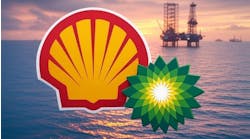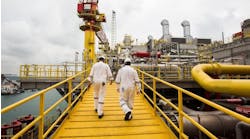Britain’s Oil & Gas Authority has awarded contracts to PGS and WesternGeco for the second government-funded seismic campaign to promote underexplored areas of the UK continental shelf (UKCS).
PGS and WesternGeco have won the £20-million ($26-million) contracts to acquire seismic data from the East Shetland Platform and South West Britain, respectively. The program is anticipated to collect between 10,000 and 15,000 km (6,213 and 9,320 mi) of new seismic data from underexplored frontier areas.
PGS’Nordic Explorer is scheduled to carry out seismic surveys across the East Shetland Platform which includes the East Orkney, East Fair Isle, and Dutch Bank basins. WesternGeco’s WG Magellan is scheduled to carry out seismic surveys around southwest Britain, including the Celtic Sea, Western English Channel, Bristol Channel, St George’s Channel, and the Irish Sea.
The acquisition is due to begin this month, subject to receiving the relevant environmental approvals, and will be supplemented by selective reprocessing of legacy seismic datasets. It is expected to be completed during 4Q 2016 and released to industry in 2Q 2017, mirroring the 2015 seismic program which saw more than 40,000 line km (24,854 mi) of new and reprocessed data successfully released to industry earlier this year.
The seismic acquisition program forms part of a package of measures designed to support the oil and gas sector, announced by former Prime Minister David Cameron earlier this year. OGA said that the areas were selected following engagement with industry and endorsed by the MER UK Exploration Board.
Gunther Newcombe, OGA Director of Exploration and Production, said: “The seismic acquisition program is a critical part of OGA’s plan to revitalize exploration. Last year’s program, which covered the Rockall Trough and Mid-North Sea High areas, sparked significant interest in these frontier areas of the UKCS with more than 3,000 downloads of the standard seismic data packages.
“Studies of these areas are being carried out which will provide valuable insight into their potential ahead of the 29th Offshore Licensing Round, which we hope to announce imminently, subject to completion of the strategic environmental assessment.
“The 2016 program is focusing on underexplored frontier areas where no substantial seismic has been acquired in decades. It is expected these areas will be made available for licensing in the 31st Frontier Licensing Round, which will be held in 2018.
“The UKCS is in a unique position having recovered more than 43 Bboe to-date, yet up to 20 Bboe still remains. The challenge is now for industry to increase exploration drilling in the UKCS and work with OGA to meet our shared target of 50 exploration and appraisal wells per year by 2021.”
The UK’s 29th Offshore Licensing Round is due to open in 3Q 2016, subject to completion of the strategic environmental assessment. It covers frontier areas including the Rockall Trough and Mid-North Sea High areas.
Fugro deploys second vessel for seep survey
The multi-purpose survey vesselFugro Gausshas joined the Fugro Brasilis offshore Mexico to help complete what Fugro says is the world’s largest seep-hunting survey.
Both vessels are using hull-mounted multi-beam echosounders (12 kHz onFugro Gaussand 30 kHz on Fugro Brasilis) and sub-bottom profiler systems to map an area of about 625,000 sq km (241,313 sq mi) in the deepwaters of Mexico.
The data acquired will assist in identifying sites where deep hydrocarbon-rich fluids are escaping to the seafloor and will be used to target hundreds of sites for coring and geochemical analysis.
“Fugro has a dedicated center of excellence in Houston for seep-hunting,” explained Jim Gharib, Fugro’s Global Product Line Manager for Seep Studies. “Our recent successes include nine seep data collection and geochemical analysis projects in the Gulf of Mexico, the Caribbean, and Southeast Asia.”
The survey is being conducted for TGS as part of its industry-funded multi-client Gigante survey which also includes a regional 2D seismic survey of approximately 186,000 km (115,575 mi), gravity and magnetic data, and a regional seismic structural interpretation.
TGS aims for this project to be the most comprehensive and modern offshore Mexico dataset which ties into its existing US Gulf of Mexico regional 2D grid. The survey is designed to assist exploration and production companies in their evaluation of prospectivity offshore Mexico during forthcoming license rounds.
In other Fugro news, the company landed a $26-million contract with ONGC, for whom it will begin a major program of geotechnical investigations. The contract involves site investigation work to gather geotechnical and geohazard data at the field, which is located in the KG-DWN-98/2 block off the east coast of India. The information will support the design and subsequent installation of wellheads, manifolds, platforms, FPSO anchors, umbilicals, pipelines, and flowlines.
Fugro will deploy its deepwater geotechnical vesselFugro Voyager, which will perform the work in water depths ranging from 50 to 1,500 m (164 to 4,921 ft). The fieldwork will be followed by extensive laboratory testing, data analysis, interpretation, and integration with other data acquired by Fugro.
For ONGC’s site characterization reports, Fugro said it will integrate the geotechnical and geohazard data from this project with metocean data and AUV geophysical survey data it had acquired previously at this field. The work is due to begin before the end of 3Q.
Magseis, Sonardyne collaborate
Magseis has contracted Sonardyne International to supply acoustic positioning equipment to support a deepwater ocean bottom seismic survey for Saudi Aramco over the Red Sea. The S78 project, which Magseis is performing with Chinese contractor BGP, is expected to take nine months to complete and will involve deployment of a large network of ocean bottom recording nodes. The Ranger 2 USBL (Ultra-Short BaseLine) installed on a surface vessel, combined with small seismic transponder technologies fitted close to each node, should address concerns of uncertainty in node positioning by providing high-quality, repeatable placement in all water depths, Sonardyne says.
Magseis will deploy its proprietary marine autonomous seismic system (MASS), which applies thousands of small nodes to create a grid pattern of receivers on the seabed.





